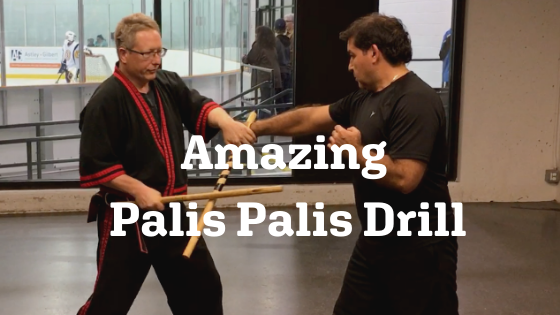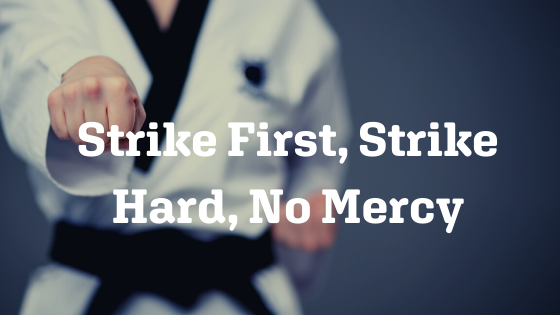Angles of Attack in Filipino Martial Arts
The twelve angles of attack are among the first things learned when starting Filipino Martial Arts.
Many Filipino Martial Arts use their version of the twelve angles of attack.
The Modern Arnis 12 angles of attack are as follows:
- Left temple;
- Right temple;
- Left arm;
- Right arm;
- A thrust to the abdomen;
- Another thrust to the left chest;
- Thrust to right chest;
- Strike to the right leg;
- Strike to the left leg;
- Thrust to left eye;
- Thrust to the right eye;
- Downward strike to the coconut!
Regardless of which FMA you are studying, the concept is that we are dealing with motions/angles of attack rather than methods of attack.
We are more concerned with the angle of attack rather than the method of attack. For example, an attack that targets the left temple of your head, whether it be empty hand, knife, stick, tote umbrella, a broken bottle, or any other implement, would be considered an angle 1 attack.
It does not matter what kind of attack it is as long it’s a recognized angle of attack.
This greatly simplifies the learning curve. Rather than learning separate techniques for each method of attack, you only need to respond appropriately to an angle of attack.
For example, do you need to memorize 50 defences against a knife attack and 50 techniques against hook punches?
NO!
You only need to address the angle from which the attack is coming.
In some cases, you will need to slightly modify your self-defence techniques and/or footwork depending on the weapon being used by your opponent (shorter blade vs. a longer blade, for example).
Once you have angle recognition, footwork becomes paramount.
Correct footwork increases the chances of a successful defence and counter. Careless footwork or improper body positioning will lead to a bad outcome.
How do I have the students practice the 12 angles of attack? There are various fun ways to do this.
- Have them practice the 12 angles backward (12, 11, 10, and so on).
- Practice the 12 angles left-handed.
- Have the students practice the 12 angles as a two-man set.
- Call out the angles rapidly and see if they hit the correct angle.
- Have the beginner student feed the 12 angles to a senior student.
- Have the student practice the twelve angles with a traditional move.
Of course, there are more ways to practice them!
Learning the twelve angles of attack in Modern Arnis in my classes has been stressed from day one. To put a spin on a quote by Morpheus from “The Matrix:” “You learn the 12 angles, you stay in Wonderland, and I show you how deep the rabbit hole goes.”
To the instructors, how often do you have your students practice the 12 angles, and in what ways?
Additional Reading
- Four Reasons Why Filipino Martial Arts Suck
- Fix It Friday: Which Way?
- The Most Dangerous Angles in FMAs
- 3 Great Reasons For One Step Sparring
- Three Reasons Why Filipino Martial Arts Suck
Share this post:
- Click to share on X (Opens in new window) X
- Click to share on Facebook (Opens in new window) Facebook
- Click to share on LinkedIn (Opens in new window) LinkedIn
- Click to share on Threads (Opens in new window) Threads
- Click to share on WhatsApp (Opens in new window) WhatsApp
- Click to email a link to a friend (Opens in new window) Email
- Click to share on Pinterest (Opens in new window) Pinterest
Related
Brian Johns
Related Posts
9 Comments
Leave a ReplyCancel reply
Categories
- Arnis/Kali/Eskrima (138)
- Book Review (8)
- DVD Reviews (3)
- Guest Post (4)
- Inspiration (25)
- Martial Arts (115)
- My story (99)
- Safety (16)
- Tips & tricks (6)
- Uncategorized (3)
- YouTube Videos (8)






[…] I divided my combinations into two-count, three-count, and four-count combinations to improve my left hand and increase the variety of left hand attacking combinations. The combinations are based on the Modern Arnis angles of attack. […]
[…] of the greatest values in learning Filipino Martial Arts is learning the angles of attack and corresponding defenses against each […]
[…] that the standard palis palis is most appropriate against angles of attack that are, at its highest, the shoulder level. In other words, angles 3 and 4. See the below clip to […]
[…] Mr. Mann is pulled out of his vehicle, another attacker attacks him with a right-handed angle 12 attack. See below. For those unfamiliar with Filipino Martial Arts terms, angle 12 refers to an overhead […]
[…] I got into Modern Arnis and learned about the angles of attack, I realized that, except for minor modifications, that attacks could be dealt with according to the […]
[…] Mary-Anne) enthusiastically participated in the 2-hour class. I focused on the basics such as the 12 angles, single sinawali, and both cane and empty-handed. I also introduced the basic block, check, and […]
[…] The focus is on the angles of attack. […]
[…] Mr. Mann is pulled out of his vehicle, another attacker attacks him with a right-handed angle 12 attack. See below. For those unfamiliar with Filipino Martial Arts terms, angle 12 refers to an overhead […]
[…] Angles of Attack in Filipino Martial Arts […]